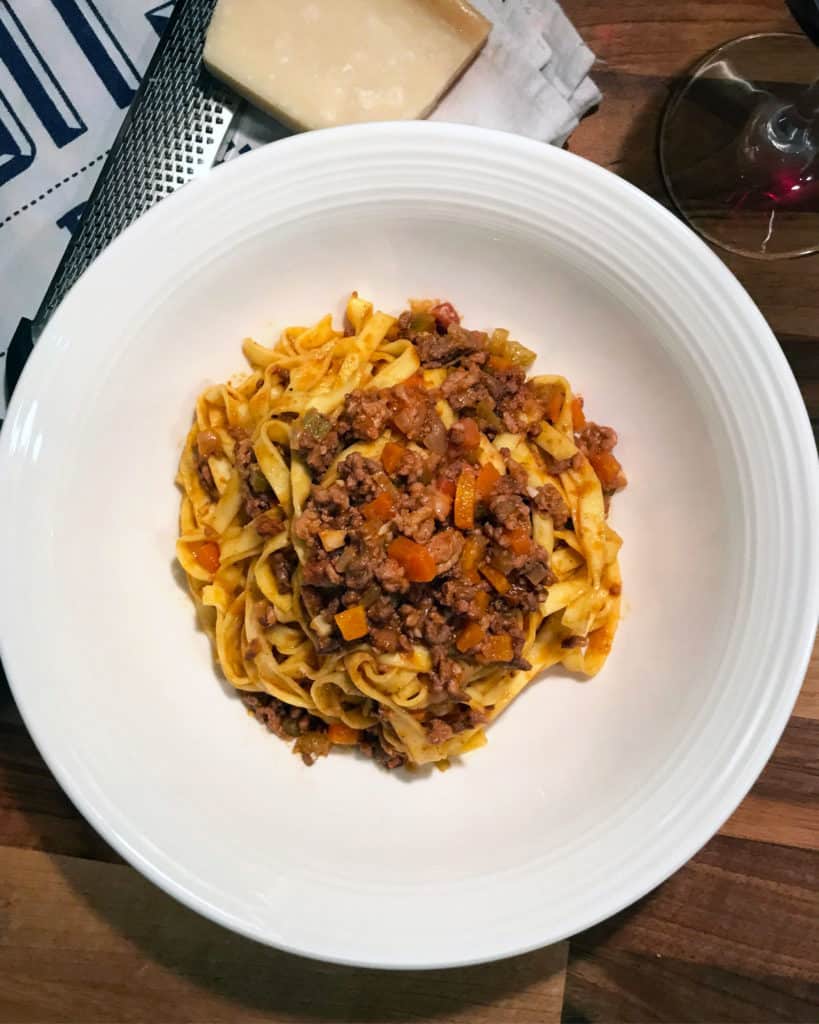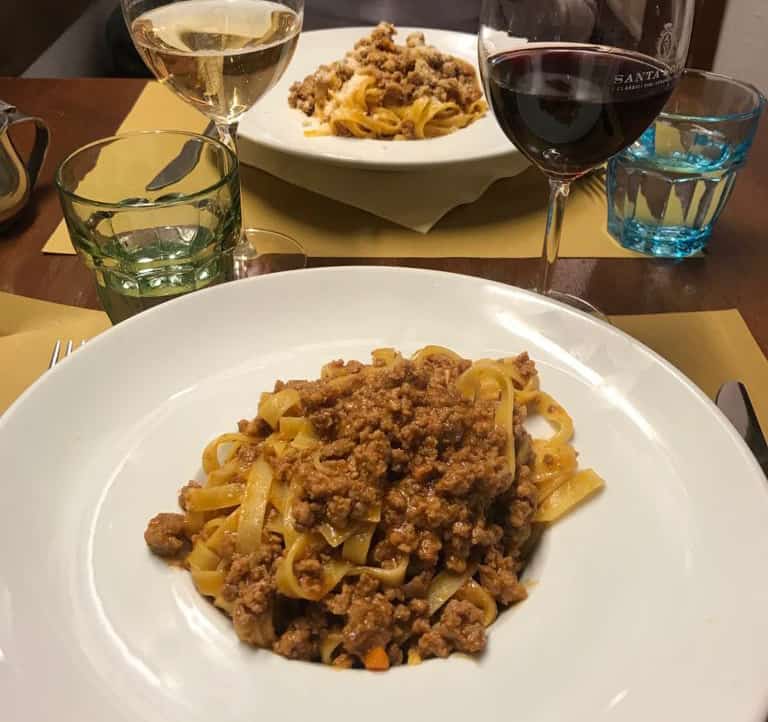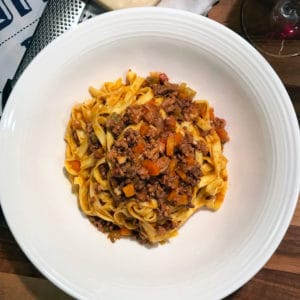Ragù alla Bolognese aka bolognese sauce is one of my family favourite meals. It’s simple, hearty and delicious.
Whilst in my teens I started working in kitchens. I quickly became fascinated on different types of food, their origins and the story behind them.
With bolognese having so many variations in sauce. I decided to travel to the home of bolognese and much more, Bologna.

Looking for more traditional Italian pasta recipes? Try these 5 easy traditional Italian pasta recipes or traditional Italian pasta fagioli recipe.
Travelling to Bologna
Bologna is in the region of Emila Romagna of Italy. This region is food heaven for all fellow food lovers. Whilst travelling through Emila Romagna you can try the likes of Prosciutto di Parma DOP, Parmigiano Reggiano DOP, Aceto Balsamico DOP and many varieties of fresh pasta plus much more!
Whilst travelling in Bologna I found a 159 year old trattoria called Del Rosso. This trattoria is in high regard for traditional Bologna cuisine.
I made this the first place I would try a proper Bologna ragu alla bolognese. The bolognese was served with fresh tagliatelle which is the traditional pasta served with bolognese. The sauce was rich and full of meaty flavours. Not like the tomato version you will find in most restaurants outside of Italy.
Academia Italiana della Cucina (1982 )
They officially registered the recipe with the Bologna Chamber of Commerce. The registered recipe states that Bolognese sauce must contain onions, celery, carrots, pancetta, ground beef, tomatoes, milk and white wine.
Tips for a Bologna Bolognese
- The longer you simmer the bolognese sauce the better it gets
- Do not use garlic, herbs or spaghetti
- Once the pasta is cooked, add the pasta into the sauce to let the flavours combine into the pasta
- Serve with Parmigiano Reggiano
- Lastly Enjoy!

Recipes You May Like

Ragù alla Bolognese
Equipment
- Large Pot
Ingredients
- 50 ml Extra virgin olive oil
- 50 g Butter
- 1 large Onion finely diced
- 4 small Carrots finely diced
- 2 Celery sticks finely diced
- 125 g Pancetta unsmoked & cut into small cubes
- 500 g Beef mince
- 500 g Pork mince
- 250 ml White wine
- 500 ml Whole milk
- 500 g Passata
- 500 ml Beef stock
- Sea Salt & Pepper
Serve with
- Fresh Tagliatelle
- Parmigiano Reggiano
Instructions
- In a large sauté pan over a medium heat, cook the pancetta for 4-5 minutes or until slightly crisp. Add butter and oil, once the butter has melted add onions, carrots and celery and sauté for a further 5-6 minutes or until soften.
- Turn up the heat and quickly add the beef and pork mince, season with salt and pepper. Now break up the mince using a wooden spoon and keep stirring letting the meat liquid evaporate. Once the mince has browned turn down the heat to medium.
- Next add the wine and with a wooden spoon deglaze the pan (scrape any brown bits stuck to the bottom of the pan). Once the wine has evaporated add milk, passata & beef stock. Bring to the boil then turn the heat to low and simmer gently for at least 2 hours adding water if needed. Check and stir once every 15-30 minutes.
- When the Bolognese is nearly finished, taste and season with salt and pepper. Then cook the pasta in a pot of generously salted boiling water until al dente. Drain the pasta and stir into the Bolognese sauce.
- Serve fresh from the pan with freshly grated parmigiano reggiano.
Notes
- We use 20% percent pork & beef mince for full flavour but feel free to buy lower fat percent mince meat for a healthier bolognese (it will still be delicious).
- Fresh Tagliatelle is not included in the nutrition information
Cecilia Bailey
Friday 13th of May 2022
Delicious! Slow cooked mine for 5hrs and used red wine instead but really good recipe! Bologna has the best version of bologonese.
Jack Slobodian
Monday 23rd of May 2022
Thank you!
Lisa
Tuesday 25th of August 2020
I haven't been to Italy, Jack. Still, I could taste the dish here. Thanks for the feast!
Jackslobodian
Tuesday 25th of August 2020
Hey Lisa, I am really happy you enjoy it and no problem! :)
Heidy L. McCallum
Tuesday 14th of January 2020
I love ragu alla bolognese, however, I love an authentic ragu alla bolognese, and this recipe looks fitting. I am incredibly excited to try your recipe out with my Mom and grandmother who are from Italy and see what they think.
I will let you know how the recipe turns out soon! Have a wonderful day and thank you Sincerely Heidy L. McCallum
Jackslobodian
Tuesday 21st of January 2020
Hi Hiedy,
I know that Italian Grandmothers are hard to please! Do let me know how it went, I am very interested. I hope you also have a wonderful day.
Jack
Jill
Tuesday 14th of January 2020
Bolognese sauce is the best. One of my favorites. I'm a bit jealous that you've actually been to Bologna!
Jackslobodian
Tuesday 21st of January 2020
I will have to agree with that statement :P. I 100% recommend going there. It's a city full of food culture and the home to many famous Italian Ingredients, especially in the Emilia-Romagna region.
Here are a few ingredients from the region Parma Ham, Balsamic Vinegar (DOP) Parmigiano Reggiano DOP, Tortellini, Gnocchi & much more.
Here are a few recipes you will find. Bolognese Ragú, Tortellini en Brodo, Pumpkin Ravioli, Erbazzone (like a savoury pie) & again a ton more!
A great trip if you don't mind putting on a few pounds :)
Angela Allison
Tuesday 14th of January 2020
This recipe is so good! The flavors are spot on and would make any Nonna proud. Thanks so much for sharing.
Jackslobodian
Tuesday 21st of January 2020
Thank you Angela :)